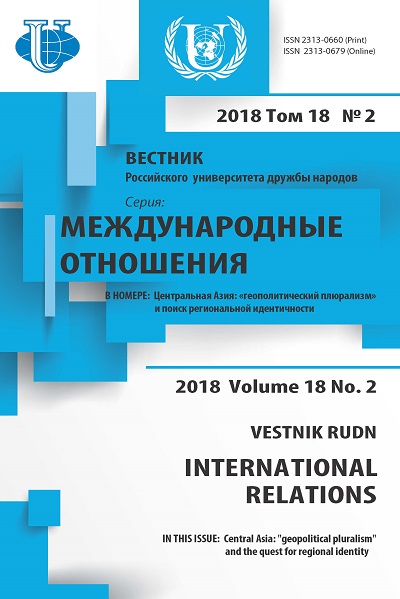POST-SOVIET CENTRAL ASIA AND AFGHANISTAN AT THE INTERSECTION OF THE MAJOR ASIAN STATES’ INTERESTS
- 作者: Malysheva D.B.1
-
隶属关系:
- Primakov National Research Institute of World Economy and International Relation
- 期: 卷 18, 编号 2 (2018): Central Asia: “geopolitical pluralism” and the quest for regional identity
- 页面: 259-272
- 栏目: THEMATIC DOSSIER
- URL: https://journals.rudn.ru/international-relations/article/view/18878
- DOI: https://doi.org/10.22363/2313-0660-2018-18-2-259-272
- ID: 18878
如何引用文章
全文:
详细
The article is analyzing the current situation in Afghanistan; it reveals the challenges and risks that emanate from this conflict zone and affect the security sphere of the five post-Soviet states of Central Asia (CA) and their Asian neighbors. Attention is paid to the growth of drug trafficking and the terrorist threat from Afghanistan by the “Islamic state” (IS, a terrorist group banned in Russia). The diplomatic initiatives taken by Russia, China, and other states to achieve national reconciliation in Afghanistan are considered. Military-political and economic projects in Central Asia (“One Belt, One Way”, and “China-Pakistan Economic Corridor”), which are alternatives to the Russia-initiated integration in the sphere of economy (Eurasian Economic Union - EAEU) and security (the Collective Security Treaty Organization - CSTO) are analyzed taking into account the rivalry within the China-India-Pakistan triangle. In connection with the recent changes in the Asian strategy of the United States, the peculiarities of India-Pakistan interaction with the post-Soviet states of Central Asia and with Afghanistan have been revealed. The chronological framework of the article is а period following the partial withdrawal from Afghanistan in 2014 of the American military contingent, brought to the beginning of 2018, when a new geopolitical reality began to form in the Central Asian region.
作者简介
Dina Malysheva
Primakov National Research Institute of World Economy and International Relation
编辑信件的主要联系方式.
Email: dsheva@mail.ru
Doctor of Political Sciences, Head of Section, Centre for Post-Soviet Studies, Primakov National Research Institute of World Economy and International Relation, Russian Academy of Sciences
参考
- Afghanistan in 2017. A Survey of the Afghan People. (2017). The Asia Foundation. URL: https://asiafoundation.org/publication/afghanistan-2017-survey-afghan-people/ (accessed: 04.01.2018).
- Afghanistan Opium Survey 2016. Cultivation and Production. Executive Summary. (2016). United Nations Office on Drug and Crime. URL: http://www.unodc.org/documents/press/releases/ AfghanistanOpiumSurvey2016.pdf (accessed: 17.11.2017).
- Azami, D. (2016). The Islamic State in South and Central Asia. Survival, 58 (4), 131—158. doi: 10.1080/00396338.2016.1207955.
- Barabanov, O., Bordachyov, T. & others. (2017). The Importance of Being Earnest: How to Avoid Irreparable Damage. Valdai Discussion Club Report. Moscow. (In Russ.).
- Belokrenitsky, V.Ya. & Sikoev, R.R. (2014). The Taliban and the Prospects of Afghanistan and Pakistan. Moscow: Institute of Oriental Studies. (In Russ.).
- Challenges to Security in Central Asia. (2013). Moscow: Institute of World Economy and International Relations. (In Russ.).
- Clarke, M. (2016). ‘One Belt, One Road’ and China’s emerging Afghanistan dilemma. Australian Journal of International Affairs, 70 (5), 563—579. doi: 10.1080/10357718.2016.1183585.
- Fallon, Th. (2015). The New Silk Road: Xi Jingping's Grand Strategy for Eurasia. American Foreign Policy Interests, 37(3), 140—147.
- Dynkin, A. & Ivanova, N. (Eds.) (2015). Global “Perestroika”. Transformation of World Order. Moscow: Ves Mir Publishers.
- Humanitarian Response Plan. January 2018 — December 2021. United Nations Office for the Coordination of Humanitarian Affairs (OCHA). (2017). URL: https://www.unocha.org/sites/ unocha/files/dms/afg_2018_humanitarian_response_plan_0.pdf (accessed: 17.02.2018).
- India and Central Asia. (2004). New Delhi.
- Is Regional Strategy Viable in Afghanistan? (2010). Washington: Carnegie Endowment for International Peace.
- Luzyanin, S. (2016). Bound by One Belt. Outlines of Global Transformations, 6 (9), 41—59. (In Russ.).
- Malysheva, D. (2016). Post-Soviet Central Asia and its Asian Neighbours. Russia and New States of Eurasia, Moscow, 4, 19—30. (In Russ.).
- Malysheva, D. (2017). The Afghan Crisis and Post-Soviet Central Asia. World Economy and International Relations, 8, 14—23. (In Russ.).
- Morozov, Yu.V. (2016). The strategy of the West in the Central Asian region at the beginning of the XXI century. Moscow: Institute of the Far East. (In Russ.).
- Umarov, A.A. (2017). Afghanistan and the Regional Security of Central Asia: the Beginning of the XXI century. Tashkent. (In Russ.).
- Rashid, A. (2010). Taliban, Militant Islam, Oil and Fundamentalism in Central Asia. Second edition. Yale University Press.
- Rashid, A. (2012). The Future of America, Pakistan and Afghanistan. London: Penguin Books.
- Regional Security Outlook 2018. (2018). The Council for Security Cooperation in the Asia Pacific. URL: http://www.cscap.org/uploads/docs/CRSO/CSCAP2018WEB.pdf (accessed: 17.02.2018).
补充文件








